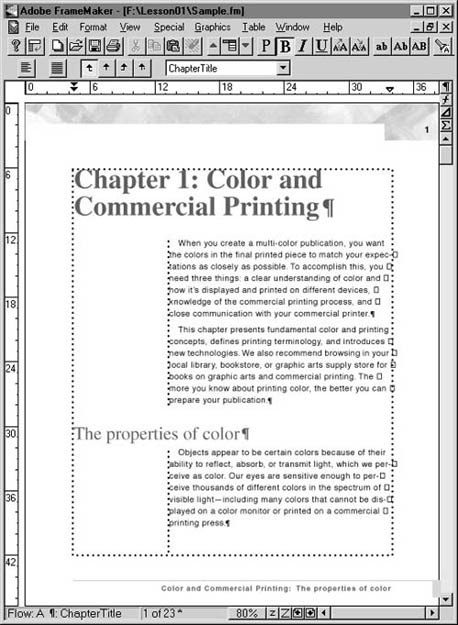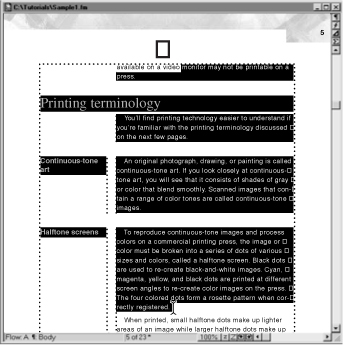Lesson 1. Working with FrameMaker 7.0 Documents
The FrameMaker 7.0 document window contains aids for writing, illustrating, viewing, and navigating within a document. The look of a document is determined by its template, which provides page layouts and predefined formats for paragraphs and selected text.
In this lesson, you’ll learn how to do the following:
• Set up the work area.
• Show and hide document window guides.
• Display pages and zoom in on them.
• Format paragraphs by applying formats from a document’s Paragraph Catalog.
• Format words and phrases by applying formats from a document’s Character Catalog.
• Create a document from a standard template.
Getting started
During this lesson, you’ll save documents as you work on them. If you haven’t already done so, you should copy the folder containing the sample documents, and then start FrameMaker 7.0.
1. Copy the lessons folders as described in “Installing the Classroom in a Book fonts” on page 3.
2. If FrameMaker 7.0 isn’t already running, do one of the following to start it:
• (Windows) Double-click the FrameMaker 7.0 icon, if it is visible, or choose Start > Programs > Adobe > FrameMaker 7.0 > Adobe FrameMaker 7.0. (If you installed FrameMaker 7.0 in a folder other than Adobe, choose that folder from the Start > Programs menu.) After a few moments, the FrameMaker 7.0 application window appears.
• (Mac OS) Double-click the FrameMaker 7.0 icon. After a few moments, the FrameMaker 7.0 menus appear.
(UNIX) In a UNIX window, change to your home directory. Enter maker to start the U.S. Edition, or maker-l (lowercase L) ukenglish to start the UK English language version of FrameMaker. After a few moments, the main FrameMaker 7.0 window appears.

Setting up the work area preference
When you first launch FrameMaker 7.0, the program gives you the choice of working in standard FrameMaker or Structured FrameMaker.
1. The FrameMaker 7.0 application opens with the Choose Interface dialog box.
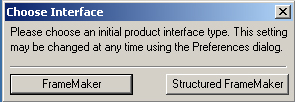
2. Click FrameMaker to select the standard FrameMaker application interface.
You will use the (unstructured or standard) FrameMaker interface for the first 15 lessons in this Classroom in a Book; and Structured FrameMaker for lessons 16, 17, and 18.
3. If this is your first use of FrameMaker 7.0 since installation, you may be prompted to register the program. Follow the instructions as appropriate.
The Adobe FrameMaker Document window now appears with work area and commands defined for (unstructured) word processing and document production.
Changing the interface preference
If you have been operating or exploring Structured FrameMaker prior to starting this lesson, you may have noticed that the main menu options are different from standard FrameMaker.

Main menu bar in standard FrameMaker 7.0.

Main menu bar in Structured FrameMaker. Note the menu title Element is an added feature in this mode.
To properly set up for Part One, the first 13 lessons of this book, please be sure you are in standard FrameMaker 7.0 by doing the following:
1. From the main menu choose File > Preferences > General (Windows and Mac OS) or File > Preferences (UNIX). The Preferences dialog box appears.
If the last entry already reads FrameMaker or you can tell from the configuration of the main menu title bar that you are already in standard mode, skip steps 2–5; you are properly set up for Part One, the first 13 lessons.
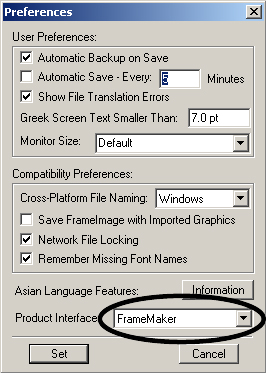
2. In the Product Interface area at the bottom of the dialog box, select FrameMaker.
3. Click Set. The application will tell you to Quit and then to Restart the program.
4. Quit FrameMaker. Choose File > Quit.
5. Restart the FrameMaker 7.0 application. After it opens, you will note from the main menu that you are operating in the standard mode.
Exploring the document window
Before you begin work on a document of your own, you’ll take a quick look at the FrameMaker 7.0 document window, which appears when you create or open a document.
Opening a document
First, you’ll open a sample document.
1. Do one of the following:
• (Windows and Mac OS) Choose File > Open.
• (UNIX) In the main FrameMaker 7.0 window, click Open.
2. Locate and open the Lesson01 folder that you copied to your hard drive. Select Sample.fm in the Lesson01 folder and click Open. The document appears in a document window.
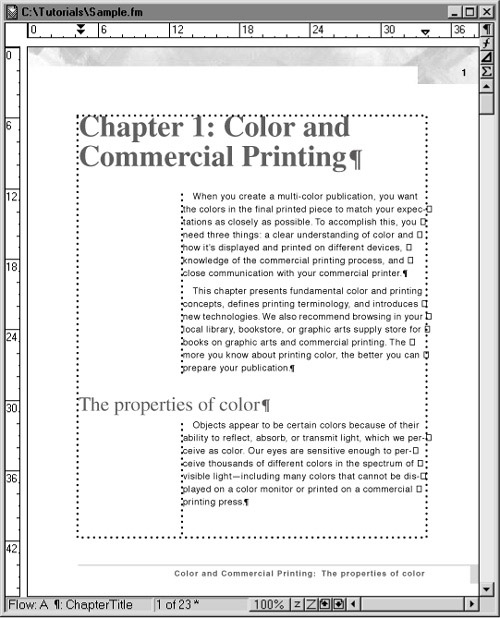
Document window
Saving a document
FrameMaker 7.0 allows you to save files in a variety of formats. For this lesson, you will save files as .fm, which will save them as standard FrameMaker 7.0 formatted files.
To save the file, choose File > Save As, enter the filename Sample1.fm, and click Save.
You’ll rename and save the documents you use in the lessons so that you can return to the unchanged originals, if you wish, without recopying them from the CD-ROM. It’s good practice to save new documents when you create them, and to save frequently when you’re editing documents.
You may want to specify a different file type. Choose File > Save As. The Format pop-up menu allows you to save a file in the following formats, among others:
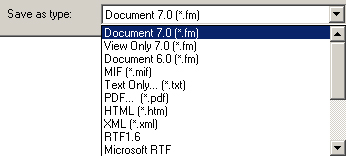
• (FrameMaker 6.0) Saves the FrameMaker 7.0 document as a 6.0 document that you can open and edit in FrameMaker 6.0.
• (MIF) Creates a text file containing FrameMaker statements that describe all text and graphics. It is a good idea to save the MIF file under a different name. (For example, add a .mif extension to the name.)
• (XML) Creates an Extensible Markup Language (XML) document that can be used for data exchange and viewed on the World Wide Web.
• (PDF) Creates a Portable Document Format (PDF) file that can be viewed in Adobe Acrobat and other applications that support PDF files.
Adjusting your view
Several controls and guides appear around the edge of the document window. The window also contains text symbols, such as the end-of-paragraph symbol (¶), and a dotted border around the editable part of the document.
You can use the top ruler to set paragraph indents and tabs.
![]()
Top ruler
You can use the formatting bar to format text. When the formatting bar is visible, it appears below the menu bar (Windows) or below the document window’s title bar (Mac OS and UNIX).
![]()
Formatting bar in Windows
You can also display the QuickAccess bar by choosing View > QuickAccess Bar. This contains shortcuts to commonly used commands.
![]()
QuickAccess bar
The status bar at the bottom of the window contains information about the document and controls for zooming and for moving through the document.
![]()
Status bar
Right now, you’re just looking at the document, so you’ll hide the formatting bar, the rulers, and the QuickAccess bar (if it’s visible). You’ll also adjust the window size and use a command in a context-sensitive pop-up menu to turn off the text symbols.
1. If the formatting bar is visible, do one of the following to hide it:
• (Windows) Choose View > Formatting Bar.
• (Mac OS and UNIX) Click the formatting bar toggle on the left side of the format-ting bar.
![]()
Formatting bar toggle
2. Choose View > Rulers to hide the rulers.
3. If the QuickAccess bar is visible, do one of the following to hide it:
• (Windows) Choose View > QuickAccess Bar.
• (Mac OS) Click the close box.
• (UNIX) Put the pointer on the bar and press Control+c.
Because you hid the rulers, the document window may now be larger than the page. If so, you’ll change the window size to fit the page dimensions.
4. If the document window is wider or taller than the page it contains (that is, if you see a gray or black area at the right side of the window, or the top of page 2 at the bottom of the window), choose Fit Window to Page from the Zoom pop-up menu (![]() ) in the status bar.
) in the status bar.
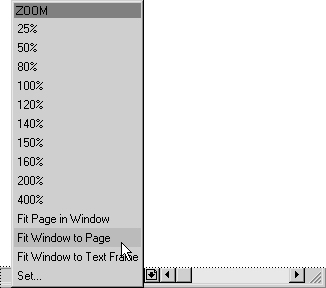
Zoom pop-up menu
To see how the document looks without the text symbols, turn them off. You could do this by using the Text Symbols command on the View menu, but instead you’ll use the same command on a context menu (a pop-up menu that contains commands that depend on the location of the pointer).
5. In the page margin (away from text), do one of the following:
• (Windows and UNIX) Right-click and choose Text Symbols from the pop-up menu.
• (Mac OS) Control-click and choose Text Symbols from the pop-up menu.
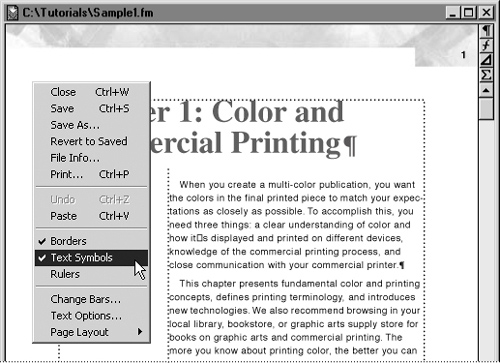
When the pointer is in the page margin, the context menu contains commands that can apply to the document as a whole. Different commands appear when the pointer is over text, a graphic, a table, and so on.
Looking at the pages
FrameMaker 7.0 documents are WYSIWYG, so they appear the same on-screen as in print. You work on pages whose page numbers, margins, headers, and footers are always visible. You add or edit contents in a text frame, marked by a rectangular dotted border in the document window. You don’t need to edit the headers and footers as you work; the headers and footers—and the entire page design—are usually set up in a template. FrameMaker 7.0 adds pages and adjusts the header and footer text for you as you work.
A. Page number in header B. Text frame C. Page footer
Next, you’ll take a quick look at a few pages of the document.
1. In the status bar, click the Next Page button (![]() ) to display page 2 of the document.
) to display page 2 of the document.

Notice that the page number, which was at the top right of page 1, appears at the top left of this page. (You may need to scroll up to see the page number.)
2. Click the Next Page button three more times to display page 5. Notice that the text in the page footer changes to reflect the first-level heading on the page (the heading Printing terminology). You may need to scroll down to see the page footer.
If the page footer is “greeked” and appears as a gray bar rather than as text, click the Zoom In button (![]() ) in the status bar until the footer appears as text.
) in the status bar until the footer appears as text.
The text frame is split into two areas:
• The area on the left is set up for side heads—headings that stand to one side of the body text.
• The area on the right is for body text.
The first-level headings straddle both areas.
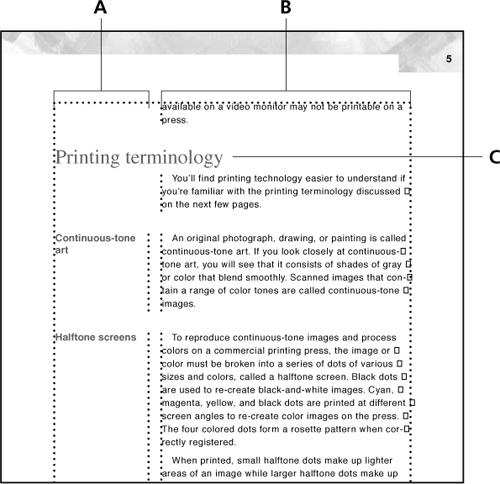
A. Side-head area B. Body-text area C. First-level heading straddles both areas
Even though the headings and the body text appear in different areas, they’re all part of a single text flow that begins on page 1 and continues to the end of the document. You can create a document that contains several independent text flows (such as a newsletter), but most FrameMaker 7.0 documents have just one main flow.
Next, you’ll select some text to see how the text flows through the document.
3. Place the pointer on the text in the first paragraph on page 5. (If you had to scroll down to see the footer, you may need to scroll up to see the first paragraph.) Then press the mouse button and drag slowly downward without releasing it.
Text is selected as you drag.
4. Continue dragging downward until the pointer moves into the status bar. The document scrolls downward to page 6, and the text continues to be selected. The graphic at the top of the text frame is also selected.

Selection crosses the page boundary.
5. Release the mouse button.
6. Click anywhere on the page to deselect everything.
7. To return to page 1, click the Page Status area in the status bar.
![]()
8. Enter 1 in the Page Number text box and click Go.

![]() You can also click the Previous Page button (
You can also click the Previous Page button (![]() ) repeatedly to get back to page 1, or just Shift-click the Previous Page button to go directly to page 1.
) repeatedly to get back to page 1, or just Shift-click the Previous Page button to go directly to page 1.
Now you’ll adjust your view again.
9. Click the Zoom In button (![]() ) in the status bar to zoom the document to 120%.
) in the status bar to zoom the document to 120%.
![]()
If you earlier zoomed to 120% to read the page footer, you do not need to zoom now. If you zoomed to a higher percentage, click the Zoom Out button (![]() ) to zoom out to 120%.
) to zoom out to 120%.
10. To save space on the screen, choose Fit Window to Text Frame from the Zoom popup menu (![]() ).
).
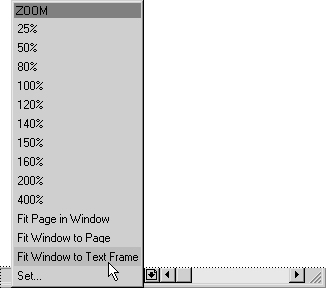
11. Choose View > Borders to hide the borders of the text frame.
Applying predefined paragraph formats
Each FrameMaker 7.0 document contains paragraph formats (styles) in a Paragraph Catalog. Each format consists of many properties—such as line and paragraph spacing, indents, alignment, tab stops, and font properties—and each format has a name, or tag. You can change the appearance of paragraphs one property at a time, but you’ll find it easier to use the formats in the catalog so that you can change many properties at once.
Looking at paragraph formats
Now you’ll display the Paragraph Catalog and look at some of the formats used in the document.
1. At the upper right of the document window, click the Paragraph Catalog button (¶).

Paragraph Catalog button
The Paragraph Catalog appears in a palette. The initial size of the palette depends on your system; you can drag a corner to resize it as needed (for example, to display more format tags).
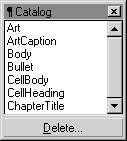
Paragraph Catalog
The Paragraph Catalog for this document includes paragraph formats for headings (for example, ChapterTitle, Heading1, and Heading2), bulleted and numbered lists (Bullet, Step, and Step1), and ordinary paragraphs of text (Body).
2. If the catalog blocks your view of the document, drag it out of the way. (You can move any FrameMaker 7.0 catalog or dialog box as needed.)
3. Click in the chapter title Color and Commercial Printing on page 1 of the document. The insertion point appears in the title, and the tag of the current paragraph appears in the Tag area of the status bar.
![]()
Paragraph tag in the Tag area of the status bar
4. Try to click in the word Chapter at the beginning of the title paragraph. Notice that the insertion point appears to the right of the chapter number and colon.
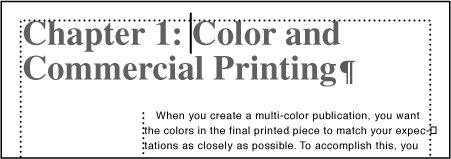
This is because the word Chapter, the chapter number, and the colon are inserted automatically as part of the chapter title’s paragraph format. You can’t place the insertion point in automatically inserted text or edit that text in the document window. (You’ll learn more about automatically inserted text and automatic numbering in the next lesson.)
5. Click in a paragraph of ordinary (body) text. The tag Body appears in the Tag area of the status bar.
![]()
6. If you like, click elsewhere in the document to see the tags of other formats used by different paragraphs. When you’re finished, return to page 1 of the document.
Applying formats to paragraphs
Next, you’ll apply some of the formats to paragraphs. It’s usually easier to work with text when text symbols and borders are visible, so you’ll display them again.
1. Choose View > Text Symbols and then View > Borders.
2. Click to place the insertion point at the end of the first body paragraph, between the period and the end-of-paragraph symbol.

3. Press the Return key (which may be labeled Enter on a PC keyboard) to insert an empty paragraph. The new paragraph’s tag is Body.
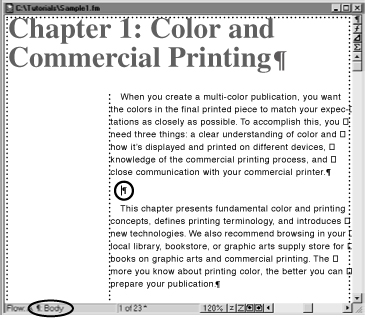
The new paragraph is a Body paragraph.
4. In the Paragraph Catalog, click Heading1. This tags the empty paragraph as a Heading1 paragraph. The properties of the Heading1 format are applied to the paragraph, and Heading1 appears in the Tag area of the status bar.
5. In the document window, type Introduction. The text appears at the insertion point.
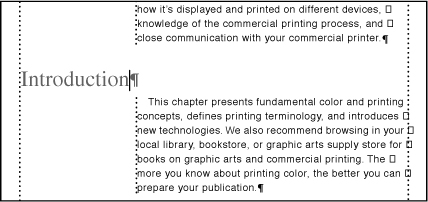
6. Choose Fit Window to Page from the Zoom pop-up menu to display as much of the document as possible at the current zoom setting. Notice that the page footer now contains the text of the new first-level heading, Introduction. (You may need to scroll down to see the page footer.)

The page footer contains the text of the first Heading1 paragraph on the page.
7. Close the Paragraph Catalog.
Applying predefined character formats
Along with a Paragraph Catalog that contains formats for entire paragraphs of text, a document contains a Character Catalog with formats you can apply to selected text, such as words or phrases. A single character format can specify several font properties, such as the font family, size, weight, angle, and color.
You can change the appearance of words or phrases one property at a time, but you’ll usually find it easier to use the formats in the Character Catalog.
1. Display page 4 of the sample document. The words in color and italics at the top and bottom of the page are technical terms. They’re formatted using a character format in the Character Catalog.

2. Click to put the insertion point in the phrase additive primaries that appears in color at the top of the page. Notice that the Tag area now contains the name of the character format—the character tag—in addition to the paragraph tag.

A. Paragraph tag B. Character tag
3. At the upper right of the document window, click the Character Catalog button (![]() ).
).

Character Catalog button
The Character Catalog appears in a palette. The initial size of the palette depends on your system; you can drag to resize it as needed (for example, to display more tags for formats).

Character Catalog
4. Double-click the word visible (at the beginning of the last paragraph on the page), and then Shift-click the word spectrum to select both words. (You can also drag to select both words.)

5. Click FirstUse in the Character Catalog, and then click anywhere else on the page to deselect the text so you can see that it now appears in color and italics.

6. Close the Character Catalog.
You’re finished with the sample document.
7. Choose File > Save and then choose File > Close.
Writing a short memo
To finish this lesson, you’ll use one of the standard templates that come with FrameMaker 7.0 to write a short memo for a sales report. When you create a new document from a standard template, that document is an untitled copy of the template. The template itself doesn’t change when you modify and save the new document.
Creating the memo from a template
First you’ll create a blank memo from a template.
1. Do one of the following:
• (Windows and Mac OS) Choose File > New > Document.
• (UNIX) In the main FrameMaker 7.0 window, click New.
The contents of the Templates folder appear in the dialog box.
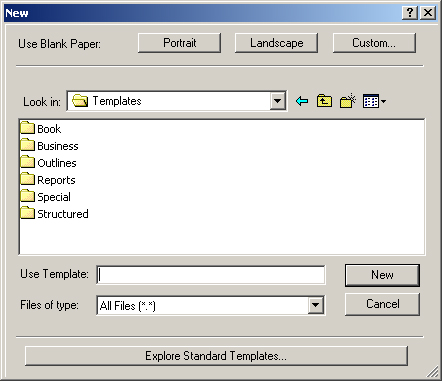
2. If the contents of the Templates folder don’t appear in the dialog box, do one of the following:
• (Windows and Mac OS) Navigate to the Templates folder in the FrameMaker 7.0 folder.
• (UNIX) Click Cancel, click Exit in the main FrameMaker 7.0 window, restart FrameMaker 7.0, and then repeat step 1.
You’ll use the Memo template in the Business folder.
3. Double-click Business and then double-click Memo.fm.

Untitled memo
The memo appears as an untitled new document.
4. Choose File > Save, make sure you are in the Lesson01 folder, and then enter the filename SalesMemo.fm and click Save.
Entering text and applying formats
The memo contains two text frames. You’ll use the small text frame at the top of the page for your name and address, and the large text frame for the body of your memo.
Near the top of the page is the date on which this memo was last modified. (Because you’re creating the memo now, today’s date appears there.) The date, the word memo, and the gray image of a world map were placed on a master page (a special page that controls a page design for the document) when the Memo template was created.
To make it easier to enter text, you’ll turn on borders and text symbols.
1. Choose View > Borders and then View > Text Symbols.
2. Click in the small text frame at the upper right of the page. The paragraph in the text frame uses the CompanyName paragraph format, as shown in the status bar.
![]()
3. Choose Edit > Select All in Flow to select all the text in the frame.
4. Type your name and press Return/Enter. Your name replaces the selected text.
5. Type your address, pressing Return/Enter to start a new line as needed.
6. To redisplay the page, press Control+l (lowercase L). A FrameMaker 7.0 variable on the master page causes your name to appear in large bold type along the left side of the page. (You may need to scroll down the page to see your name along the side.)
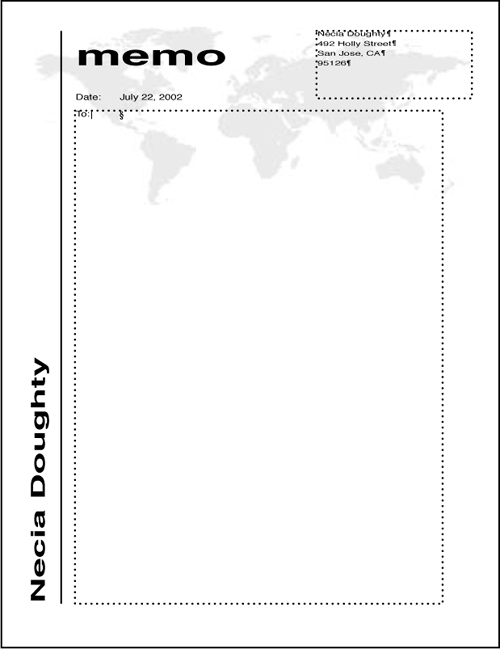
7. Click to the right of the word To in the large text frame.
The word To—like the word Chapter and the chapter number in the sample document you looked at earlier—is inserted automatically as part of the paragraph’s format (MemoTo).
8. Type Sales Department Staff and press Return/Enter.

The next paragraph uses the MemoFrom format, as shown in the status bar. This format begins with the word From.
9. Type your name and press Return/Enter.
The next paragraph uses the MemoSubject format, which begins with the word Re.
10. Type September Sales and press Return/Enter.
The next paragraph uses the MemoCc format. This format begins with the text Cc and is followed by a thin line. The line, like the text Cc, is automatically inserted as part of the paragraph format.

11. To leave the Cc line blank, press Return again.
The next paragraph begins the body of the memo, and it uses the Body paragraph format.
12. Type Sales for September should exceed expectations for several reasons: and press Return.
Next you’ll type a short bulleted list.
13. At the right side of the document window, click the Paragraph Catalog button (¶) to display the Paragraph Catalog again.
FrameMaker 7.0 is a powerful program that enables you to create and edit an extensive variety of documentation types; later lessons will explore many of these other types of documents.
14. In the catalog, click the Bulleted format.

The Body paragraph changes to Bulleted.
15. Type Strong sales of existing products and press Return.
16. Type Rapid acceptance of our new products and press Return.
17. Type Favorable exchange rates. The memo is finished.
18. Close the Paragraph Catalog. Save and close the document.
Moving on
You’ve completed this lesson. For in-depth information about the work area, document window, entering and editing text, and applying paragraph and character formats, see Chapter 1, “Work area”; Chapter 2, “Working with FrameMaker 7.0 Documents”; Chapter 3, “Word Processing”; and Chapter 4, “Text Formatting,” in the Adobe FrameMaker User Guide.
Review questions
1. How do you set the standard FrameMaker work area?
2. How do you show and hide rulers, borders, and text symbols?
3. How do you zoom in for a closer look at a document’s contents?
4. What is the primary difference between paragraph formats and character formats?
5. How do you open the Paragraph Catalog and the Character Catalog?
6. How do you apply a paragraph format from the catalog?
7. How do you apply a character format from the catalog?
8. What happens when you create a document from a template?
Answers
1. When you initially launch the program, click on FrameMaker in the Choose Interface dialog box. After initial use, go to the main menu and choose File > Preferences > General and then select FrameMaker from the Product Interface pop-up menu.
2. Choose View > Rulers, View > Borders, and View > Text Symbols. (You can also choose these commands from the context menu when the pointer is in the page margin.)
3. In the status bar, click the Zoom In button or choose a setting from the Zoom pop-up menu.
4. Paragraph formats apply to entire paragraphs; character formats apply to selected text, such as words and phrases.
5. Click the Paragraph Catalog button in the upper right corner of the document window; click the Character Catalog button in the upper right corner of the document window.
6. Click to put the insertion point in the paragraph, then click the format’s tag in the Paragraph Catalog.
7. Select the text to which you want to apply the format, then click the format’s tag in the Character Catalog.
8. FrameMaker 7.0 creates an untitled copy of the template, leaving the template unchanged. You can give the copy a different filename by using the Save As command.

